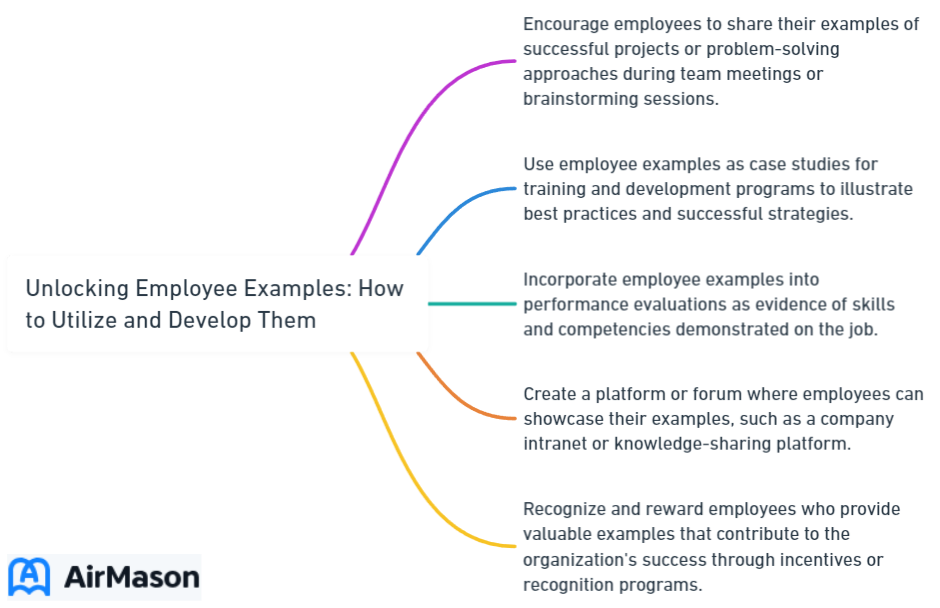
In today’s fast-paced business world, the key to unlocking the full potential of your team lies in understanding and utilizing employee examples effectively. By recognizing and developing employee strengths and addressing weaknesses, you can foster a growth mindset and a culture of continuous feedback, ultimately driving success in your organization. Ready to unleash the power of effective employee feedback? Let’s dive in!
Key Takeaways
- Unlock employee potential and drive success in 2024 by providing positive feedback, focusing on solutions, and utilizing 1-on-1 meetings & peer-to-peer feedback.
- Recognize strengths to increase engagement & loyalty while actively listening for areas of improvement.
- Implement tools to track growth as you create a culture of continuous development that will foster collaboration and success!
Employee Definition
The “employee definition” is a crucial concept in the realm of human resources and employment law. It refers to the legally recognized status of an individual within an organization, distinguishing them as someone engaged in work under a contract of employment. The “employee definition” encompasses various factors, including the nature of the work relationship, the level of control exerted by the employer, and the presence of key employment elements such as regular wages and benefits. Understanding the “employee definition” is essential for both employers and employees, as it determines rights, obligations, and the application of labor laws. Clarity on this definition helps in establishing a fair and compliant working environment.
The Importance of Employee Examples
Employee examples play a crucial role in the modern workplace, positively impacting job satisfaction, team morale, and overall productivity. An organization that embraces a culture of effective employee feedback not only boosts employee engagement but also promotes alignment and drives progress towards common goals.
The question is: how can one utilize employee examples to maximize success in a company? The significance of employee satisfaction, team morale, and a positive attitude in the workplace is worth investigating.

Employee Satisfaction
Promoting satisfaction hinges on the recognition of employee achievements and provision of constructive feedback. Studies have shown that happy workers are 13% more productive than their unhappy counterparts, and when workplace satisfaction is high, productivity can increase by an average of 31%. This means that acknowledging employee successes and offering constructive feedback to further grow and develop can lead to higher customer loyalty and lower staff turnover, further boosting productivity and your organization’s success.
Employee feedback plays a significant role in boosting satisfaction by:
- Motivating workers
- Recognizing their positive behavior
- Promoting professional growth
- Uplifting morale
Through meaningful and constructive feedback, employees can gain confidence in their abilities and performance, and feel appreciated and valued for their contributions. This, in turn, creates a positive and engaging work environment where employees can thrive.
Team Morale
Sharing employee examples can ignite motivation and foster a sense of unity among individual team members, resulting in a more productive and successful work environment. Some activities that can be great tools to motivate your team and provide feedback include:
- ‘Lunch and learns’
- Project team meetings
- Instant messaging systems
- Team bulletin boards
- After-action reviews
These activities can ultimately contribute to the company’s success.
Collaboration tools like Slack and Asana, enabled by technology, make feedback exchange among teams effortless, irrespective of their health insurance status. By fostering open communication and collaboration, your team can work together more effectively, ultimately driving success for your organization.
Positive Attitude
Employee examples can foster a motivating environment by recognizing achievements and inspiring growth through helpful feedback. Maintaining a positive attitude in the workplace brings numerous advantages, such as increased productivity, improved teamwork and collaboration, heightened job satisfaction, reduced stress, and a vibrant work environment.
A manager can cultivate a positive attitude in an employee by:
- Exhibiting strong leadership abilities
- Establishing a supportive atmosphere
- Giving useful feedback
- Enabling employees
- Maintaining a positive attitude themselves
By promoting a positive attitude, your organization can unlock the full potential of your entire team and drive success at every level.
Types of Employee Examples

While exploring the realm of employee examples, understanding the diverse types that can inspire and motivate your team becomes indispensable. Positive feedback, negative feedback, and development goals are all great examples of inspiring employee examples. By using these different types of feedback, you can help foster growth in your employees and create a dynamic, successful team.
Examining each of these types of employee examples, including seasonal employees and temporary employees, will reveal how they can stimulate development and growth in your organization.
Positive Feedback Examples
Positive feedback serves as an influential instrument for acknowledging the achievements of employees and their effect on the organization. By providing specific examples of employee successes, you can motivate employees to continue performing at their best, while also helping them feel valued and appreciated.
Examples of inspiring positive feedback include statements like, “I’m really impressed by your capacity to successfully lead a remote team”. By using such examples, you can effectively acknowledge and appreciate employee achievements, ultimately driving satisfaction and productivity in the workplace.
Negative Feedback Examples
Negative feedback, when presented objectively and focused on behaviors and their outcomes, can help individuals identify areas for improvement. With the provision of objective and actionable feedback, employees can comprehend their weaknesses better and strive to surmount them.
Delivering negative feedback effectively is crucial to its success. Here are some tips to help you do it:
- Give employees a heads-up before the feedback.
- Keep the feedback constructive and focused on specific behaviors or actions.
- Ensure your emotions are in check and approach the conversation with a calm and professional demeanor.
- Provide the feedback in a private area to maintain confidentiality and avoid embarrassing the employee. By following these guidelines, you can help employees understand their areas for improvement and empower them to make necessary changes for their growth and development.
Development Goals Examples
Development goals form a pivotal aspect of employee growth. By setting clear and achievable goals for employees to strive towards, you can encourage ongoing development and help employees reach their full potential.
To help employees set attainable development goals, consider the following steps:
- Encourage them to develop new skill sets
- Assist them in enhancing workplace skills
- Provide opportunities for leadership responsibilities
- Support their expansion of professional networks
- Guide them in creating a vision and developing a plan
- Track progress
- Review the plan regularly
By doing so, you can foster a growth mindset and create a workforce that is continuously improving and adapting to new challenges.
Employee in Business
In the dynamic landscape of contemporary workplaces, understanding the role of an employee in business is pivotal. Employee in business encapsulates the myriad expectations and responsibilities individuals carry within an organizational framework. From contributing to the overall productivity to aligning with the company’s values, an employee in business plays a crucial role in shaping the success trajectory. This symbiotic relationship between the employee and the business fosters a collaborative environment, where both parties benefit from mutual growth. Navigating challenges and seizing opportunities, an engaged employee in business becomes an integral asset, contributing to the overall prosperity of the organization.
Effective Employee Feedback Strategies

Having investigated the various types of employee examples, we can now discuss strategies for delivering effective feedback. Here are some strategies to consider:
- Active listening: Take the time to fully understand the employee’s perspective and actively engage in the conversation.
- Providing specific examples: Use concrete examples to illustrate your feedback and make it more tangible for the employee.
- Focusing on solutions: Instead of dwelling on the problem, focus on finding solutions and offering constructive suggestions for improvement.
By employing these strategies, you can ensure that your feedback is impactful and actionable, ultimately driving growth and development in your organization.
A detailed examination of each of these feedback strategies will reveal their utility in establishing a culture of incessant improvement in your workplace.
Active Listening
Active listening constitutes a critical element of efficacious employee feedback. By actively listening to employees during feedback conversations, you can promote open communication, ensure a better understanding, and foster a supportive environment for growth and development.
To employ active listening techniques in your feedback process, consider:
- Asking open-ended questions
- Paraphrasing and summarizing what you have heard
- Giving feedback to the speaker
- Following up on feedback
- Having consistent one-on-one coaching
- Seeking out team members’ opinions
- Turning casual conversations into coaching opportunities to receive feedback
By doing so, you can create a feedback culture that is both effective and supportive.
Providing Specific Examples
The inclusion of specific examples during feedback sessions is crucial for rendering feedback more actionable and influential. By using concrete examples to illustrate areas of success or improvement, you can help employees better understand their performance and identify areas for growth.
To provide specific examples in employee feedback, follow these guidelines:
- Be organized, direct, honest, and respectful in your delivery
- Focus on performance rather than personality
- Show empathy and understanding when discussing mistakes or areas for improvement
- Keep the feedback private and confidential
- Provide clear goals and guidance for improvement
By following these guidelines, you can ensure that your feedback is meaningful and effective, ultimately driving employee growth and development.
Focusing on Solutions
Concentrating on solutions, instead of fixating on past errors, fosters a growth mentality and enables employees to realize their maximum potential. By concentrating on future-oriented solutions, employees can feel motivated to overcome challenges and develop new skills.
Some examples of solution-focused feedback include “Cassandra, you have been an amazing asset to our team and connected us with valuable clients” or “Let’s start with what’s been good and focus on the outcome.”. By emphasizing the positive aspects, focusing on solutions, and encouraging growth and development, you can create a feedback culture that drives success and continuous improvement.
Developing Employee Strengths and Addressing Weaknesses

Driving success in your organization necessitates the acknowledgment and cultivation of employee strengths as well as addressing weaknesses through focused feedback and training. By understanding employee strengths and weaknesses, your organization can unlock increased efficiency, employee satisfaction and productivity, and an increased competitive advantage.
Exploring techniques to acknowledge employee strengths and address weaknesses will aid in the creation of a workforce that is perpetually growing and adapting to novel challenges.
Recognizing Employee Strengths
The recognition and celebration of distinctive employee talents and traits contributing to effective job performance is vital to cultivating a success-driven culture. Recognizing employee strengths has a range of positive outcomes, such as:
- Increased employee engagement
- Higher levels of creativity and innovation
- Improved performance and productivity
- Greater job satisfaction and trust-building
- Boosted team morale
- Increased employee retention and loyalty
- Enhanced overall job satisfaction
Examples of employee strengths include:
- Strong communication skills
- Excellent problem-solving abilities
- Leadership qualities
- Technical expertise
- Creativity and innovation
- Time management skills
- Adaptability and flexibility
By acknowledging these strengths, you can effectively utilize the unique abilities of your employees and drive success in your company.
Addressing Employee Weaknesses
The process of addressing employee weaknesses, which provides constructive feedback and support, is critical for assisting employees in reaching their maximum potential and acquiring new abilities. By providing constructive feedback to employees about their weaknesses, you can help them understand their areas for improvement and empower them to make necessary changes for their growth and development.
To provide constructive feedback, follow these steps:
- Give employees a heads-up before the feedback.
- Keep the feedback constructive and focused on specific behaviors or actions.
- Ensure your emotions are in check and approach the feedback with a calm and professional demeanor.
- Provide the feedback in a private area to maintain confidentiality and avoid embarrassing the employee.
- Be direct and honest in your feedback, but avoid being harsh or overly critical. By following these steps, you can foster a growth mindset and create a workforce that is continuously improving and adapting to new challenges.
Creating a Culture of Continuous Feedback
The implementation of practices promoting consistent feedback and development – including regular 1-on-1 meetings, peer-to-peer feedback, and employee feedback tools – is crucial for nurturing a culture of unending improvement. By creating a culture of continuous feedback, you can ensure that your employees are consistently growing and developing, driving success in your organization.
Examining each of these practices will reveal their potential usage in fostering a culture of constant feedback and growth in your workplace.
Regular 1-on-1 Meetings

The arrangement of regular meetings between managers and employees for discussing performance, goals, and areas for improvement is vital for propelling success. Regular 1-on-1 meetings provide an opportunity for open communication, ensuring that employees stay on track and make progress towards their goals.
To ensure successful 1-on-1 meetings, address both the practical and personal needs of the employee, hear their concerns, give feedback, set goals, monitor progress, and identify areas for further development and growth. By doing so, you can foster a culture of continuous feedback and growth, ultimately driving success in your organization.
Encouraging Peer-to-Peer Feedback
Creating a collaborative ambiance where employees are at ease providing feedback to each other is critical for propelling success. Peer-to-peer feedback offers numerous benefits, such as:
- Helping employees grow, learn, and perform better
- Providing honest and actionable insights
- Uncovering and resolving conflicts
- Fostering problem-solving skills for growth
To empower peer-to-peer feedback, you can:
- Acknowledge the value of peer recognition
- Seek consent before providing feedback
- Emphasize specificity in feedback
- Involve employees in creating the peer recognition program
- Educate employees on the art of feedback
- Inspire employees to record informal feedback
By doing so, you can create a collaborative culture of continuous improvement and growth.
Implementing Employee Feedback Tools
The use of technology and tools for streamlining the feedback process and tracking employee progress over time is pivotal for cultivating a culture of continuous feedback. Employee feedback tools that can offer insightful feedback on successes and areas for growth, help employees gain a better understanding of their development, and address issues quickly to create a positive work environment include:
- CultureMonkey
- 15Five
- Officevibe
- Qualtrics
- TINYpulse
By implementing employee feedback tools, you can enhance your organization’s ability to provide effective feedback, track employee progress, and drive success at every level of your company.
Summary
Unlocking employee examples is crucial for driving success in today’s competitive business landscape. By recognizing and developing employee strengths and addressing weaknesses, fostering a culture of continuous feedback, and implementing effective feedback strategies, your organization can unlock the full potential of its workforce and achieve lasting success. Are you ready to harness the power of employee examples and create a thriving, growth-focused workplace?
Frequently Asked Questions
What is an example of employer?
An example of an employer is the person or organization that you work for. The telephone company is also an employer, as it is the country’s largest.
What is an example of an employee and employer?
An example of an employee and employer is when a company or institution hires an individual to perform duties and the employer is responsible for providing a safe, respectful place to work and paying the employee.
What type of employees are?
Full-time, part-time, temporary, seasonal, leased and at-will employees are all types of employees with different work contracts and benefits. Understanding each type is key to finding the best one for you.
How do you describe an employee?
An employee should be motivated, dedicated, consistent, accountable, dependable, have integrity, be committed and optimistic to achieve successful results. They should also be resourceful, diligent, efficient, reliable, committed, accomplished, ambitious and productive.
What are some effective strategies to provide feedback to employees?
Active listening, providing specific examples, and focusing on solutions are effective strategies to help employees develop their skills and improve performance.